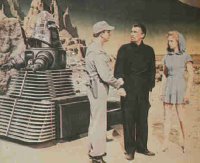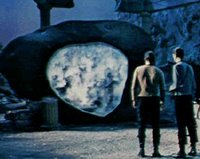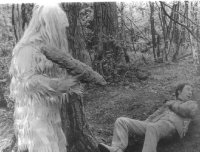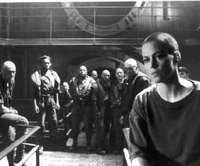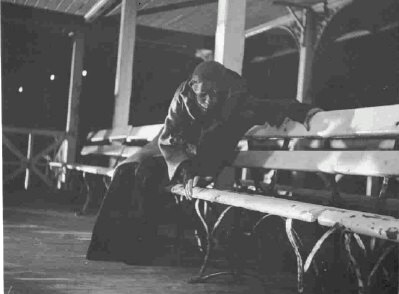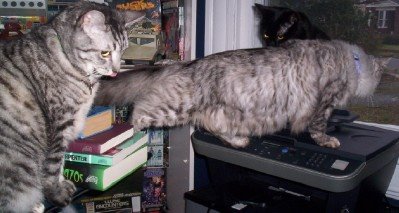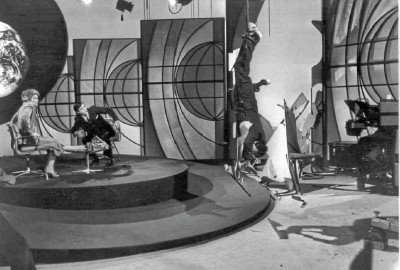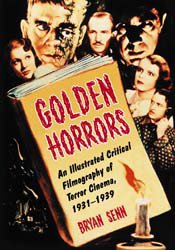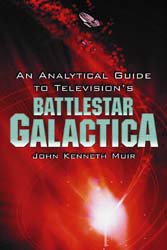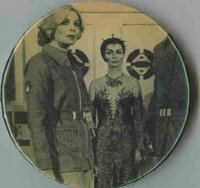I saw the Alexandre Aja remake of The Hills Have Eyes yesterday and liked it a great deal. The relatively faithful (but much embellished...) remake got me thinking again about the landmark, original film, which is a personal favorite.
For those of you who don't remember that venture from the disco decade, it's the story of a terrible clash in the desert between an extended "civilized" family, the Carters, and a group of in-bred savages. The two families are twisted reflections of one another, and only one can survive in the inhospitable, scorching terrain.
In the 1977 version, the Carters (a so-called "whitebread" family) were represented by a bigot named Big Bob, his long-suffering wife, young siblings Brenda and Bobby, older daughter Lynn and her diffident husband Doug. They also brought along their baby, Katherine, and the family's two dogs: Beauty and the Beast. The bad guys were represented by psychotic madmen with names like Papa Jupiter, Pluto and Mercury. The Jupiter clan - though undeniably deranged - was well organized and disciplined in its attack on the Carters, who had become stranded in the desert following an accident on the road with their trailer.
The film didn't get great reviews when it was released, and yet to horror fans, it's a classic of the savage cinema. One of the most famous sequences involves one of the madmen twisting the head off the Carters' parakeet like its a beer can tab, and then drinking the bird's blood from its open throat. There's also a crucifixion/burning, a rape, and several point-blank gun shot wounds. The movie is harrowing, brutally unsentimental...and deeply relevant to modern America.
Here's my review (of the original):
Wes Craven's 1977 feature, The Hills Have Eyes is a dedicated re-working of the siege film, a genre in which a group of characters are isolated in a remote location and attacked from all corners by enemies. In horror, the "siege" has been vetted well by George Romero in Night of the Living Dead (1968) and by John Carpenter in Assault on Precinct 13 (1976).
Many critics have suggest that The Hills Have Eyes boasts roots going further back in film history even than those notable examples, in Westerns such as The Alamo. Not surprisingly, then, the Craven film can easily be fit into the Western film mold with a few contemporary modifications. To wit, a group of pioneers (here vacationers...) head west in a wagon train (here a recreational vehicle; a trailer), only to be savagely assaulted by a group of primitives (not American Indians as in the cowboy tradition, but in-bred cannibals). However, to gaze upon The Hills Have Eyes as merely another entry in the siege genre does this horror a disservice. Wes Craven is famous for imbuing his films with sub-text and social commentary, and this film is no exception.
The heart of The Hills Have Eyes is actually the duel between two families, one from "civilization" and one from the wild. The battle for supremacy takes place not on neutral territory, however, but in the home court of the savage clan, in this case, the barren, rocky landscape of the Yucca Desert. The landscape plays a critical role in the film and Craven defines a chaotic terrain of danger that is as much nemesis to the Carter family as is Jupiter's killer clan.
The Carters - named after then-President Carter, perhaps? - stumble upon a vast world of inhospitable hills and rock. It is a world where their enemies can come and go as they please and yet remain hidden, because of their camouflage. The Carters bear no such protection, and the hard right angles of their trailer stand out like a beacon against the random outcroppings of the terrain. The Carters are just they (aptly) describe themselves in the film's finale: sitting ducks.
The desert turns even more dangerous by night. The darkness provides a natural shroud, - yet another brand of camouflage - for the activities of the marauding cannibals. Again, the Carters are out of their element. Even in the darkness of night, they constantly have a campfire burnng outside their trailer, and all the lights on inside of it. They possess the only illumination in the entire desert, and it too serves as a sort of beacon, drawing their opponents ever closer like moths to the flame.
Because they are the products of contemporary urban life, the Carters are instantly uncomfortable once trapped in Craven's forbidding landscape. Brenda repeatedly asserts that dwelling outside gives her "the creeps." The others naively insist clean air is "good" for them, but they do not respect the land. Instead of adapting to their new surroundings, they attempt to tame it and control the land . Almost immediately, they set up a dinner table outside the trailer....and begin to picnic. It is a ridiculous scene as the Carters rotely fold their napkins and set out their silverware in orderly fashion...amidst a vast wasteland. From this scene alone, it is clear that they are truly out of touch with their location and have no notion of the dangers it boasts, or how to cope with them. This is the first blow against them in their deadly war with Papa Jupiter.
The Carters are woefully out of their element in another fashion too. Although they're on unfamiliar ground, they continue to rely on technology that has failed. Their car breaks down, stranding them and making them susceptible to attack in the first place. Then the trailer's battery goes dead and they are plunged into darkness. Next, the members of the family depend on modern weaponry that they have never used before. At one point, Bobby has a clear shot at Mars with his pistol and misses three times. Brenda is just as lost, asking at one point, "How do you use this thing anyway?" Even Big Bob Carter - who should know better given his years on a police force - cannot effectively harness his "howitzer" pistol.
Other technology proves equally troubling. The CB Radio - which should help contact rescuers - ends up as a tool with which they hand over critical defensive information to the enemy. Their car "betrays" them again when the gas is siphoned by Pluto and used to set the captured Big Bob aflame. Even the chain leash with which the family tethers the Beast breaks. The result is that the dog runs off when the family needs him most. If Beast were present during the attack by Pluto and Mars, Mrs. Carter and Lynn might not have been killed.
It is only when the Carters forsake the tools of 20th century man that they begin to successfully defend themselves. They only defeat Jupiter once they stop viewing their trailer as a shelter, a mobile representation of their suburban safety, and instead use it as a weapon and blow it to smithereens. Similarly, they kill Papa Jupe once they have forsaken Brenda's ridiculous car axle gimmick for a handy hatchet (it might as well be a tomahawk...). As for Doug, he only beats Mars when he embraces a knife instead of the surplus supplies he has brought back from the abandoned PX base. It is only by resorting to basics that the Carter family can compete in a world where their technology is meaningless
It is not just the landscape and untrustworthy technology that imperils the Carters, it is the now meaningless family conventions they cling to as well. Early in the film, the family gathers together and prays. No one wants to do it, and the prayer accordingly has a rote, mechanical feel. Yet still the family gathers together like Zombies and prays for the Lord to look over them. In the very next shot, - a long view lensed from at least half-a-mile away - their total isolation is revealed. They are in the middle of nowhere, so prayer is not a practical solution.
Worse, their wishes to be taken care of by an invisible deity are undercut by the fact that they are already being watched over. Not by God, but by Pluto, the evil brother and a kind of God of the desert. The Carters cannot grasp the danger of their predicament and so apply pat societal remedies as prayer to a world where neither civilization nor religion hold sway. To defeat the cannibal clan, the Carters must give up societal constructs (like prayer) and fight brutally. They do, even harnessing the bodies of their dead as a decoy.
Only when the Carters go "native" and fight force with blunt, brutal force, are they able to preserve what's left of their family. The final freeze frame of The Hills Have Eyes reveals Doug hovering viciously over Mars' corpse. It is a shot which suggests the lesson has been learned. Man has violent tendencies just beneath the surface, instincts he can tap even with hundreds of year of civilization behind him. When the frame then turns blood-red, the indication is that man is a creature awash in blood and that there is no real difference between civilized people who supposedly have law and morality, and wild sociopaths who roam the hills. Both will fight and kill to protect their families. Civilized people just take a little pushing...
Many have read very deep Vietnam War allegories into The Hills Have Eyes, because they see a primitive enemy defeating a technologically superior force. And indeed, the destruction of the trailer brings to mind the Vietnam-era adage "to save a village, you must destroy it." Still, I propose the film is much more closely related to situations inside America than to any foreign war. Our real enemy resides not in a faraway land, but right here, under the auspices of a failed social safety net. Whole classes of people have remained down-trodden for so long while a middle class has flourished. Accordingly, some people become desperate as health care, medicine, gasoline and even food fall out of economic reach. In situations without law (not unlike the aftermath of Katrina...) some of these "have nots" act desperately - even viciously - to survive a terrible situation.
This movie represents a battle between the haves and those have nots. The film opens with a pan across a barren highway, and it is immediately apparent that this region is a wasteland. Young Ruby, one of the savage family, begs for food and establishes that her family is starving. The Jupiter clan is thus desperate to survive, on the edge of extinction - and though this no way justifies their evil - it does make their actions at least comprehensible. Like the Carters, they must fight for survival in a world without resources. Jupe's clan does not have the benefits of refrigerators, vehicles, air conditioning, or even artificial light, for that matter. The battle between the cannibals and the Carters in The Hills Have Eyes is thus not symbolic of the Viet Cong versus the U.S., but rather representative of a single house divided: the poor of America versus the wealthy....in the one place where the poor can fight back: on a leveled playing field. No tax cuts for the rich are going to help the Carter family in the desert.
Craven weaves all of these themes into a 90-minute motion picture of escalating terror, brilliantly staging the siege on the Carters in increasingly fear-provoking waves. First a spider invades the trailer, signifying what is to come, a kind of invasion vanguard. Then the first dog is killed. Then Big Bob is killed in what today we'd euphemistically term "a decapitation strike." Then the RV is totally overtaken, and so on. Incident builds upon incident until the viewer is overwhelmed, and fully half the Carter family is already dead. The film maintains this startling pace throughout, and leaves audiences in shock. The Hills Have Eyes packs a visceral punch, and this film doesn't play favorites with characters. It's a raw, unsentimental and horrific glimpse of class warfare; of the disenfranchised striking back.
And it's a great horror movie. The new film has a different spin. But more on that later.




